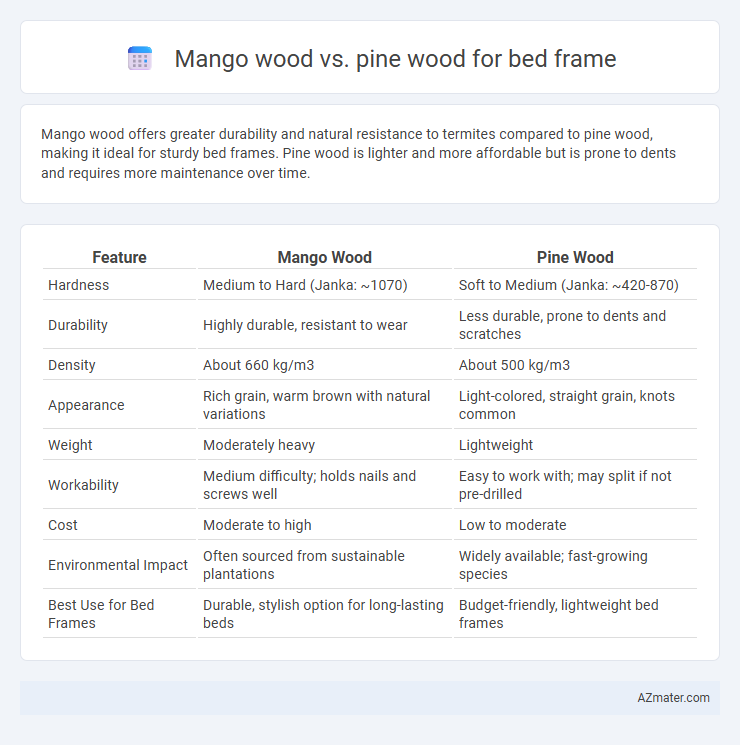Mango wood offers greater durability and natural resistance to termites compared to pine wood, making it ideal for sturdy bed frames. Pine wood is lighter and more affordable but is prone to dents and requires more maintenance over time.
Table of Comparison
| Feature | Mango Wood | Pine Wood |
|---|---|---|
| Hardness | Medium to Hard (Janka: ~1070) | Soft to Medium (Janka: ~420-870) |
| Durability | Highly durable, resistant to wear | Less durable, prone to dents and scratches |
| Density | About 660 kg/m3 | About 500 kg/m3 |
| Appearance | Rich grain, warm brown with natural variations | Light-colored, straight grain, knots common |
| Weight | Moderately heavy | Lightweight |
| Workability | Medium difficulty; holds nails and screws well | Easy to work with; may split if not pre-drilled |
| Cost | Moderate to high | Low to moderate |
| Environmental Impact | Often sourced from sustainable plantations | Widely available; fast-growing species |
| Best Use for Bed Frames | Durable, stylish option for long-lasting beds | Budget-friendly, lightweight bed frames |
Introduction: Mango Wood vs Pine Wood for Bed Frames
Mango wood offers exceptional durability and unique grain patterns, making it ideal for premium bed frames with a natural aesthetic. Pine wood is lightweight, affordable, and easy to work with, preferred for budget-friendly, rustic-style bed frames. Choosing between mango and pine wood depends on the desired strength, appearance, and price point of the bed frame.
Overview of Mango Wood
Mango wood is a dense tropical hardwood known for its durability and unique grain patterns, making it an excellent choice for bed frames requiring strength and aesthetic appeal. It naturally resists warping and moisture, contributing to long-lasting furniture that maintains structural integrity. Compared to pine wood, mango wood offers superior hardness and rich color variation, enhancing the overall look and lifespan of bed frames.
Overview of Pine Wood
Pine wood is a softwood known for its light color, straight grain, and affordability, making it a popular choice for bed frames. It offers moderate durability and is easy to work with, but may be prone to dents and scratches compared to hardwoods like mango wood. Pine's natural knots and resin-filled pockets add a rustic charm, while its lightweight nature facilitates easier furniture handling and assembly.
Durability and Strength Comparison
Mango wood offers superior durability and strength compared to pine wood, making it an excellent choice for bed frames that require long-lasting support. Its dense grain structure provides higher resistance to wear and damage, while pine, being a softer wood, is more prone to dents and scratches over time. The robustness of mango wood ensures enhanced stability and a longer lifespan for bed frames, outperforming the lighter and less durable characteristics of pine wood.
Visual Appeal and Aesthetics
Mango wood offers a rich, warm grain with natural variations and a smooth finish that enhances the visual appeal of bed frames, creating a rustic yet elegant look. Pine wood features a lighter color with a more uniform grain pattern, lending a bright and casual aesthetic ideal for minimalist or Scandinavian styles. Both woods can be stained or painted, but mango wood's distinctive texture and color depth generally provide a more sophisticated and durable appearance for bedroom furniture.
Sustainability and Environmental Impact
Mango wood is considered more sustainable than pine wood due to its status as a byproduct of mango fruit harvesting, reducing the need for additional tree felling. Pine wood, typically sourced from fast-growing plantations, can lead to monoculture practices that negatively affect biodiversity and soil health. The lower carbon footprint of mango wood, coupled with its durability, makes it an environmentally friendly choice for bed frames.
Maintenance and Care Requirements
Mango wood bed frames require moderate maintenance involving regular dusting and occasional oiling to maintain their natural luster and prevent drying or cracking. Pine wood, being softer, needs more frequent care to avoid dents and scratches, and should be sealed or painted for better moisture resistance. Both woods benefit from avoiding excessive exposure to humidity and direct sunlight to ensure long-lasting durability.
Cost and Affordability
Mango wood bed frames typically cost more due to the wood's density, durability, and natural resistance to pests, making it a long-lasting investment for quality bedroom furniture. Pine wood is generally more affordable, favored for budget-conscious buyers, but it is softer and less durable, leading to potential wear and damage over time. Choosing between mango and pine wood depends on balancing upfront cost with long-term affordability and durability considerations.
Popular Styles and Design Flexibility
Mango wood offers rich, warm tones and unique grain patterns that suit eclectic and rustic bed frame styles, providing high design flexibility for personalized or artisanal furniture. Pine wood, known for its light color and smooth texture, is popular in minimalist, Scandinavian, and farmhouse bed frames due to its versatility and easy customization through staining or painting. Both woods support diverse design preferences, with mango wood favoring bold, statement pieces and pine wood excelling in adaptable, budget-friendly options.
Final Verdict: Which Wood is Better for Bed Frames?
Mango wood offers superior durability and a rich, natural grain that resists warping, making it ideal for long-lasting bed frames with aesthetic appeal. Pine wood is softer and lighter, which can lead to dents and scratches over time, but it remains budget-friendly and easy to work with. For a bed frame that balances strength, longevity, and visual beauty, mango wood is generally the better choice.

Infographic: Mango wood vs Pine wood for Bed Frame
 azmater.com
azmater.com